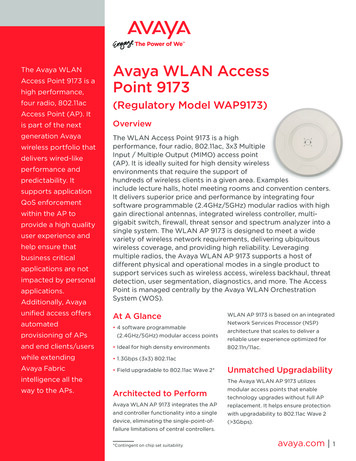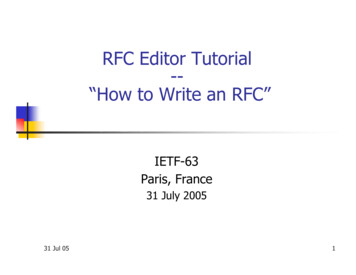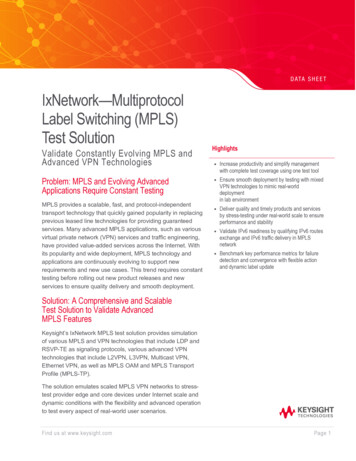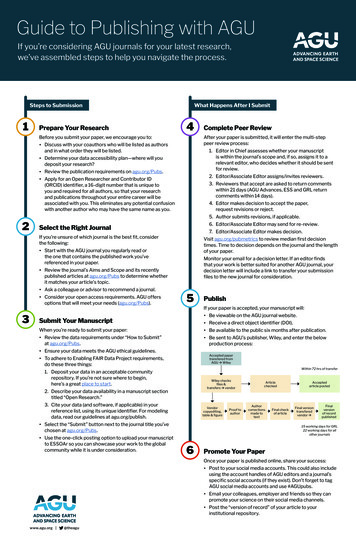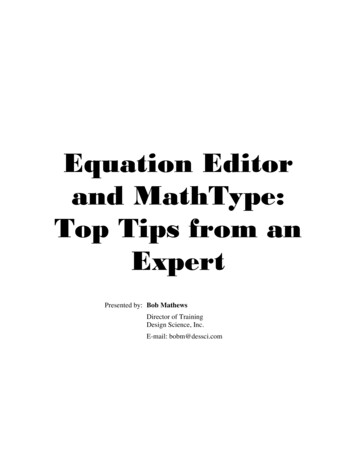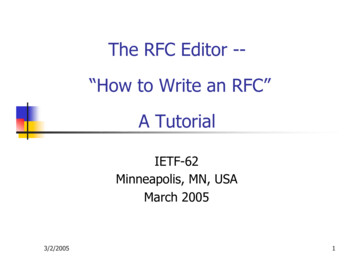
Transcription
The RFC Editor -“How to Write an RFC”A TutorialIETF-62Minneapolis, MN, USAMarch 20053/2/20051
Goals of this TutorialIntroduction to the RFC process fornewcomers Hints for old hands. Improve quality of product Hasten publication Overview of the process. Review some important editorialpolicies and formatting rules – Gotchas. 3/2/2005RFC Editor2
Grateful acknowledgment: Avri Doria’s slidesfrom IETF 61 were our starting point.No time to explain everything in detailSee references, especially:http://www.rfc-editor.org3/2/2005RFC Editor3
Overview of this Tutorial Background: The RFC Series and the RFC Editor The Publication Process How to Write an RFC Some Persistent Issues3/2/2005RFC Editor4
Background A (very short) history lesson Jon PostelThe RFC Editor todayThe RFC Series 3/2/2005Relation to the IETFIndependent submissionsRFC Editor5
Historical Context Short chronology of Internet technology: 1969-1983: ARPAnet protocol development 1975-1985: Internet protocol development IP, TCP, RIP, ARP, DNS, 1985-1990: NSFnet1991-today: Commercial Internet 3/2/2005NCP, Telnet, FTP, SMTPHTTP protocolRFC Editor6
RFCs RFC document series Begun by Steve Crocker [RFC 3], Jon Postel in 1969Informal memos, technical specs, and much more.Jon Postel quickly became the RFC Editor. 3/2/200528 years: 1970 until his death in 1998.Postel had an enormous influence on the developingARPAnet & Internet protocols – known as the “ProtocolCzar” and the “Deputy Internet Architect”.He established and maintained the consistent style andeditorial quality of the RFC series.Jon was a 2-finger typist.RFC Editor7
Jon PostelNewsweek Aug 8, 19943/2/2005Photo by Peter Lothberg – IETF34 Aug 1995RFC Editor8
Jon Postel’s Playful Side April 1 RFCs A little humorous self-parody is a good thing Most, but not all, April 1 RFCs are satirical documents. We expect you can tell the difference;-)April 1 submissions are reviewed for cleverness,humor, and topical relation to IETF themes. Avian Carriers is famous [RFC 1149]The Evil Bit is my favorite [RFC 3514]3/2/2005RFC Editor9
As the ARPAnet/Internet went from research toproduction to commercial, the technicalcommunity served by the RFC Editor morphed andgrew. The IAB created the IETF [1985]The standards process crystalized, with occasionalminor upheavals.The IETF ate its parent and started over [Kobe 1992].Through these events, the RFC Editor kept righton publishing, adapting its rules to the changingenvironment but trying hard to maintainconsistency, quality, and integrity of RFC series.3/2/2005RFC Editor10
The RFC Editor today A small group at Jon’s long-term home, the Information Sciences Institute (ISI) of USC.4-5 FTEsFunded by ISOC.Current leadership: 3/2/2005Joyce Reynolds, Postel’s chief editorial assistant 83-98.Bob Braden, colleague of Postel 70-98.Aaron Falk, newcomer.RFC Editor11
The RFC Editor Web sitehttp://www.rfc-editor.org Search engines for RFCs, Internet Drafts Publication queue Master index to RFCs: rfc-index.html, .xml “Official Internet Protocols Standards” list Errata Policy changes, news, 3/2/2005RFC Editor12
Errata Page www.rfc-editor.org/errata.html A list of technical and editorial errors that have beenreported to the RFC Editor.Verified by the authors and/or the IESG.The RFC Editor search engine results contain hyperlinks toerrata, when present.3/2/2005RFC Editor13
The RFC Series Earliest document series to be published online.1969 – today: 36 years old.3900 documents.An ARCHIVAL series: RFCs are forever!A nearly-complete record of Internet technicalhistory 3/2/2005Early RFCs: a treasure trove of technical history.Many “wheels” that we repeatedly re-invent.RFC Editor14
RFC Publication Rate3/2/2005RFC Editor15
RFCs and the IETF RFCs have always been the archival series forInternet standards documents.The RFC Editor is therefore one component of thestandards process, under IAB supervision.[RFC 2026]An RFC Editorial Board drawn from IETFcommunity provides advice and counsel to theRFC Editor, particularly about independentsubmissions.The RFC Editor has a dual loyalty: to the IETFprocess, and to the RFC series.3/2/2005RFC Editor16
Two Kinds of RFCs IETF submissions Most come from Working Groups.A few are individual submissions to IESG.All are submitted to the RFC Editor by the IESG, afterapproval and with announcement to community.RFC Editor (“independent”) submissions 3/2/2005Submitted directly to RFC Editor.IESG reviews for conflict with IETF activity, makespublish/do-not-publish recommendation. RFC Editor hasfinal decision, with advice from Editorial Board.Only Experimental or Informational category.RFC Editor17
Why Independent Submissions (1)? Document proprietary protocols Encourage companies to publish their protocol designsSocially desirable behavior Republish output of other standards bodies, tomake it easily available to Internet community. 3/2/2005More socially-desirable behaviorRFC Editor18
Why Independent Submissions (2)? Repository of technical history To record important new ideas, including perhapscontroversial ideas.To help counter possible ossification of the IETFtechnical discourse.Document minority views in WG discussions 3/2/2005This may be, but will not always be, a BAD reason.RFC Editor listens carefully to what WG chairs and IESGsay. IESG can say “[Please] Do Not Publish Now”,providing up to 1.5 years delay.RFC Editor19
Some Common Questions Why does every RFC say “Network WorkingGroup” at the top? A reminder of our history [RFC 3] (1969).“I want to read RFC 219, but the index says “notonline”. 3/2/2005The early archive (RFCs 1-800) did not survive thechangeover from TOPS20 to Unix around 1983.Volunteers have been retyping early RFCs.There are still about 80 that have not been typed andproof-read.RFC Editor20
Common Question Why do Internet Drafts expire after 6 months? 3/2/2005Experience with RFCs in the early days showed thevalue of having ONE archival series, the RFC series. Toavoid accidentally creating a competing archival series,the early IAB made I-Ds expire.There has been much heated discussion about whetherthis is still a good idea.RFC Editor21
The Internet Standards process RFC 2026 rules.It defines document maturity levels: Shown on RFC header as “Category:” Standards track: Proposed, Draft, Standard.Non-standards track: Experimental, Informational,Historical.Not quite either: Best Current Practice.Except, one category “Standards Track”A published RFC can NEVER change, but its categorycan change (see rfc index.txt).3/2/2005RFC Editor22
RFC Publication Process OverviewQueue statesAUTH48 procedureContents of an RFC3/2/2005RFC Editor23
Publication Process: Overview (1) First published as an Internet Draft RFC Editor Send us the nroff or xml2rfc source, if available.Copy-edits for clarity, syntax, punctuation, Creates official nroff source containing editorial changesMakes many consistency checksIANA acts on IANA Considerations Creates new registries, assign numbers, informs RFC EditorRFC Editor plugs assigned numbers into document.3/2/2005RFC Editor24
Publication Process: Overview (2) Publication may be held up by other RFCs. An RFC # is assigned.Document and diff file sent to authors for final check “REF” state: doc set linked by Normative refs must bepublished simultaneously.“AUTH48” state.All named authors are responsible.Finished document added to archive and index. Announcement on ietf-announce list.nroff files archived, for later revision.3/2/2005RFC Editor25
3/2/2005RFC Editor26
3/2/2005RFC Editor27
The RFC Editor Does Edit At least, for correct syntax and punctuation.Ideally, to improve clarity, consistency, and qualityof the prose.To maintain consistent format and style. 3/2/2005Using the format and style that many, many years ofexperience have been found to work well.RFC Editor28
The RFC Editor checks many things 3/2/2005Header format and contentTitle formatAbstract length and formatTable of ContentsRequired sections are presentNo uncaught IANA actionsSpell checkABNF/MIB/XML passes mechanical checkerCitations match referencesMost recent RFC/I-D citedPure ASCII, max 72 char lines, hyphens, etc.Headers and footerRemove “widows”References split into Normative, InformativeBoilerplateRFC Editor29
AUTH48 State: Final Author Review Authors given rfcxxxx.txt file and diff file (.html)Last-minute editorial changes allowed – But should not betechnically substantive or too extensive. Else, must get OK from AD, WG chair.This process can involve a fair amount of work & time AT LEAST 48 hours!All listed authors must sign off on final documentCritical that editors take it seriously - review the entire document, notjust the diffs.Your last chance to avoid enrollment in the Errata Hall of Infamy!3/2/2005RFC Editor30
General RFC Policies ImmutabilityNot all RFC’s are standardsLanguage - all RFCs in English RFC2026 allows translations British English is allowed in principle, but Consistent Publication Format ASCII (also .txt.pdf for Windows victims)Also .ps or .pdf (special process for handling)3/2/2005RFC Editor31
RFC Formatting Rules ASCII, 72 char/line.58 lines per page, followed by FF ( L).No overstriking or underlining.No “filling” or (added) hyphenation across a line. . sp sp between sentences.No footnotes.3/2/2005RFC Editor32
Parsing an RFC HeaderTitleHeader boilerplate (Short copyright, Status of Memo)IESG Note (when requested by IESG)AbstractTable of Contents (not req’d for short docs)BodyAuthors’ AddressesIPR boilerplate 3/2/2005See RFC 3667/BCP 78, RFC 3668/BCP 79.RFC Editor33
RFC HeaderNetwork Working GroupRequest for Comments: 3986STD: 66Updates: 1738Obsoletes: 2732, 2396, 1808Category: Standards Track STD number: labels a standard (as opposed to adocument) T. Berners-LeeW3C/MITR. FieldingDay SoftwareL. MasinterAdobe SystemsJanuary 2005One STD may include a set of related RFCs.An STD number will be re-assigned to replacement RFC(s)IETF considering elaboration of STD idea into an “InternetStandards Document (ISD)”Updates, Obsoletes: relation to earlier RFCs.3/2/2005RFC Editor34
RFC Header: another exampleNetwork Working GroupRequest for Comments: 2396Updates: 1808, 1738Category: Standards TrackT. Berners-LeeMIT/LCSR. FieldingU. C. IrvineL. MasinterXerox CorporationAugust 1998Corresponding RFC Index entry (search on “2396”)RFC2396 T. Berners-Lee, R. August ASCII1998Fielding, L.MasinterObsoleted by RFC3986,Updates RFC1808,RFC1738, Updated byRFC2732ErrataDRAFTSTANDARDNote fields that were not known when RFC was published3/2/2005RFC Editor35
More First-Page StuffTitleUniform Resource Identifier (URI): Generic SyntaxStatus of This MemoThis document specifies an Internet standards trackprotocol for the Internet community, and requestsdiscussion and suggestions for improvements. Please referto the current edition of the "Internet Official ProtocolStandards" (STD 1) for the standardization state andstatus of this protocol. Distribution of this memo isunlimited.Copyright NoticeCopyright (C) The Internet Society (2005).Abstract3/2/2005RFC Editor36
Authors in Header Limited to lead authors, document editors.There must be very good reason to list more than 5.All authors in header responsible for 48 hours review.Authors section should provide unambiguous contactpoints.Others can be included in Contributors and/orAcknowledgments sections.3/2/2005RFC Editor37
Title and Abstracts Titles Should be thoughtfully chosenNo unexpanded abbreviations - except for very well known(eg, IP, TCP, HTTP, MIME, MPLS )Abstracts Carefully written for clarity (HARD to write!)No unexpanded abbreviations (again, except well-known)No citationsLess than 20 lines! Shorter is good.Not a substitute for the Introduction; redundancy is OK.3/2/2005RFC Editor38
Body of RFC First section should generally be “1. Introduction”.Following special sections may appear: Contributions, AcknowledgmentsInternationalization Considerations When needed -- see Sect 6, RFC 2277/BCP 18.ReferencesSections that MUST appear: 3/2/2005Security ConsiderationsIANA ConsiderationsRFC Editor39
References Normative vs. Informative Normative refs in stds track documents can hold up pub.[Normative gets over-used]Recommend against numeric citations [37].Citations and references must match.Handy file of RFC reference text: 005RFC Editor40
Copyrights and Patents Copyright Issues Specified in RFC 3977/BCP 77 “IETF Rights inContributions”Independent submissions: RFC Editor rules, but generallyfollows IETF rules.Differences should be of interest only to lawyers.Patent (“IPR”) issues RFC boilerplate specified in RFC 3978/BCP 78“Intellectual Property Rights in IETF Technology”3/2/2005RFC Editor41
Security Considerations Security Considerations section required in everyRFC.IESG is (rightfully!) suspicious of “There are nosecurity considerations in this document.” There are security considerations in nearly everything thatwe do.The IESG is increasingly asking for in-depth, meaningfulSC sections!See: RFC 3552: “Guidelines for Writing RFC Text onSecurity Considerations”3/2/2005RFC Editor42
IANA Considerations Primary input to IANADefines: Individual code points, in one placeNew registries (number spaces), with instructions on futureassignment rules.Section is required in draft, but “No IANAConsiderations” section will be removed by RFCEditor.See: RFC 2434, “Guidelines for Writing an IANA ConsiderationsSection in RFCs”3/2/2005RFC Editor43
How to Write an RFC Some editorial guidelinesImproving your writingToolsMIBs and formal languages3/2/2005RFC Editor44
Writing an RFC Primary goal is clear, unambiguous technical prose The RFC Editor staff generally follows two sourcesfor style advice: Some preference for American English styleStrunk & White (4th Edition, 2000)"A Pocket Style Manual" by Diana Hacker (4th Ed., 2004).In any case, internally consistent usage is required.3/2/2005RFC Editor45
Writing RFCs Simple fact: writing clear, unambiguous technicalprose is HARD !! Reread RFC 793 for inspiration and example.Not literary English, but comprehensibility wouldbe nice! 3/2/2005Avoid ambiguityUse consistent terminology and notationDefine each term and abbreviation at first use.Expand every abbreviation at first use.RFC Editor46
Lean and Mean You often improve your writing, by simply crossingout extraneous extra words. Look at each sentence and ask yourself,“Do I need every word to make my meaning clear andunambiguous?”English professors call it the “Lard Factor” (LF)[Lanham79]“If you’ve not paid attention to your own writing before,think of a LF of 1/3 to ½ as normal and don’t stoprevising until you’ve removed it.” [Lanham79][Lanham79] Richard Lanham, “Revising Prose”, Scribner’s, New York,19793/2/2005RFC Editor47
A (real) example "When the nature of a name is decided one must decidewhether the name should be of fixed length or whether itis variable length." (25 words)A. “One must decide whether the length of a name shouldbe fixed or variable.” (14 words, LF .44)B. “We may choose fixed or variable length for a particularclass of name.” (13 words)C. “A name may have fixed or variable length.”(7 words, LF .72)3/2/2005RFC Editor48
Another real example "One way to avoid a new administrative overheadwould be for individuals to be able to generatestatistically unique names." (20)A. “We can avoid new administrative overhead byallowing individuals to generate statistically uniquenames.” (14, LF .30)B. “Allowing individuals to generate statisticallyunique names will avoid new administrativeoverhead.” (12, LF .40)3/2/2005RFC Editor49
How about:“New administrative overhead can be avoided byallowing individuals to generate statistically-uniquenames.”Compare to:“The nail has been hit on the head by you!”Passive voice: generally a bad idea 3/2/2005RFC Editor50
Another (reality-based) Example 3/2/2005Original: “This is the kind of situation in which thereceiver is the acknowledger and the sender gets theacknowedgments.” (19)“We observe that an acknowledgment action is takingplace from the receiver and the sender.” (15, LF .21)“The receiver returns acknowledgments to the sender.”(7, LF .63)RFC Editor51
Writing Hints Simple declarative sentences are good. Avoid long, involuted sentences. You are notJames Joyce. Flowery, literary language is not good.Say enough, but not more than enoughUse “;” “, and” “, or” sparingly to glue successivesentences together.Make parallel clauses parallel in syntax.Bad: “ whether the name should be of fixed length orwhether it is variable length”.3/2/2005RFC Editor52
A Few Common Errors “which”s that should be “that”s. “Which” is used parenthetically and follows a comma.“The interface which the users sees is too complex.”that /Or better: “The user interface is too complex.”Should be comma before last item of series: 3/2/2005“TCP service is reliable, ordered, and full-duplex”Avoids ambiguity, clearly shows parallelism.RFC Editor53
A Few Common Errors RFC Editor convention: punctuation outside quotemarks:“This is a sentence”{. ? !} To avoid computer language ambiguities. Some Protocol Engineers over-capitalize Nouns. Keep your sentences short and direct. 3/2/2005Don’t make simple things complexRFC Editor54
iceberg3/2/2005RFC Editor55
Format for Readabilty Careful use of indentation and line spacing canmake huge improvement in readability. Goes a long way to make up lack of fancy fonts.Bullets can often help.High density on the page may be the enemy ofclarity and readability3/2/2005RFC Editor56
Hard to read3.1 RSVP Message Formats3.1.1 Common HeaderThe fields in the common header are asfollows:Flags: 4 bits0x01-0x08: ReservedNo flag bits are defined yet.Send TTL: 8 bitsThe IP TTL value with which the message issent. See Section 3.8.3/2/2005RFC Editor57
Easier to Read3.1 Message Formats3.1.1 Common HeaderThe fields in the common header are asfollows:Flags: 4 bits0x01-0x08: ReservedNo flag bits are defined yet.Send TTL: 8 bitsThe IP TTL value with which the message issent. See Section 3.8.3/2/2005RFC Editor58
Preserving the Meaning A comment that does not faze us:“How dare you change my perfect prose ”? Sorry we are just doing our job. See earlier.A comment that concerns us very much:“You have changed the meaning of what I wrote”. 3/2/2005Often, because we misunderstood what you meant.That implies that your prose is ambiguous.You should recast the sentence/paragraph to make itclear and unambiguous, so even the dumb RFC Editorcannot mistake the meaning. ;-)RFC Editor59
Internet Drafts A well-formed RFC starts with a well-formed I-DSurviving IESG review: http://www.ietf.org/ID-Checklist.html 5RFC Editor60
Text Formatting Tools Author tools: www.rfc-editor.org/formatting.html xml2rfcnroffMicrosoft word templatesLaTeXRFC Editor does final RFC formatting using venerableUnix tool nroff –ms.3/2/2005RFC Editor61
xml2rfc Read RFC2629.txt - Marshall Rose Engine to convert .xml to .txt or to .nroffavailable online at: http://xml.resource.org/ Writing I-Ds and RFCs using XMLExplains use of DTD for RFC productionIf you use xml2rfc, give the .xml file to the RFC Editor! Itsaves us doing the markup on your document.Xml2rfc resources at: http://xml.resource.org/3/2/2005RFC Editor62
nroff, groff Handy templates for authors using nroff: plate Published in 1991 - J. Postel Gives instructions on using macros for creating RFCswww.1-4-5.net/ dmm/generic draft.tar.gz Updated nroff template maintained by David Meyer.If you use nroff –ms (without a private make file),give the .nroff source to the RFC Editor.3/2/2005RFC Editor63
Microsoft word templates 2-word-template.doc Published in 2002 - T. HainUsing Microsoft Word to create Internet Drafts and RFCswww.ietf.org/rfc/rfc3285.txtTemplate can be found at: f.exeAnd at the IETF web site.Updated version: www.isi.edu/touch/tools (J. Touch)3/2/2005RFC Editor64
LaTeX Mostly private templates and methodsSometimes causes difficulty when documents areinherited by new authors.Tool for conversion of LaTeX to text: www.cs.columbia.edu/IRT/software/l2x/There are private tools to convert LaTeX subset tonroff.3/2/2005RFC Editor65
MIB RFCs – Important special case MIB references O&M Web Site at www.ops.ietf.org/MIB doctors at www.ops.ietf.org/mib-doctors.htmlMIB Review: draft-ietf-ops-mib-review-guidelinesTools nt at www.ibr.cs.tu-bs.de/projects/libsmi/SMICng at www.snmpinfo.com/3/2/2005RFC Editor66
Use of Formal Languages Formal languages and pseudo-code can be useful as an aidin explanations, although English remains the primary methodof describing protocols. Pseudo-code judged on the basis of clarity. Formal Languages (e.g., ABNF, XML, ASN.1 (MIBs)) Requires normative reference to language specification RFC Editor will run verifier UsingPseudoCode.txt3/2/2005RFC Editor67
Persistent Issues Normative references MUST/MAY/SHOULD/ applicability words Practical effect: can hold up publicationSome disagreement on what should be NormativeDo they belong in Informative documents at all?Tend to overuse – makes it sound important.Worse, often inconsistent useURLs in RFCs 3/2/2005Some are more stable than others RFC Editor68
Persistent Issues Author contact information Seems important, but hard to keep it currentRFC Editor gets many queries from newbies.Ideal: maintain database of current email addresses;daunting job.Update and Obsolete relationships 3/2/2005Some disagreement on what they meanAt best, only high-order bit of complex relationshipRFC Editor supports ISD (Internet Standard Document)[Newtrk] as a more systematic and complete definition.RFC Editor69
Persistent Issues “What are the current Internet standards?” In practice, reality is so complex that this isprobably not even a valid question. STD sub-series is supposed to define this.Again, ISDs would be better than STDs (but more work)What is meaning of Historic category? 3/2/2005“Really Bad”, or just “well, not very current ”?RFC Editor70
Authoritative references Overview of RFC tructions to Request for Comments (RFC)Authors”. Draft-rfc-editor-rfc2223bis-08.txt aka authors.txt3/2/2005RFC Editor71
Thank youQuestions? tor@rfc-editor.org3/2/200572
3/2/2005 RFC Editor 7 RFCs RFC document series Begun by Steve Crocker [RFC 3], Jon Postel in 1969 Informal memos, technical specs, and much more. Jon Postel quickly became theRFC Editor. 28 years: 1970 until his death in 1998. Postel had an enormous influence on the developing ARPAnet & Internet protocols - known as the "Protocol Czar" and the "Deputy Internet Architect".


